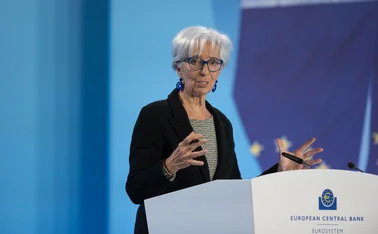
Transparency: Bank of Canada
The Canadian central bank is leading the way in many areas

It has been a busy year for the Bank of Canada's communications team. Besides the work of putting policies across in a turbulent global climate, the central bank has led academic debate on the renewal of its inflation target and engaged with the wider public on the task of putting a woman on one of its banknotes. Meanwhile, the team has been working to keep the overall communications strategy evolving, in line with the ways in which the digital generation uses and shares information.
The central bank recently created the new top-level position of "adviser to the governor and chief of staff", to which it promoted former communications chief Jill Vardy on January 3. The new role gives the team more "bench strength" to strategise on communications, "which I think is testament to how much time we are spending thinking about this", Vardy says. Jeremy Harrison, who used to be press secretary to Mark Carney, became communications chief.
We're not telling people what our policy action is going to be, but we are making sure markets understand what our reaction function will be
Jill Vardy, Bank of Canada
While keen to engage with both sophisticated stakeholders and those with a much hazier idea of what a central bank does, Vardy says the Bank of Canada also wants to ensure market participants think for themselves. The alternative – giving the impression of pinpoint accuracy when forecasting – has led other central banks into difficulty.
"We're not telling people what our policy action is going to be, but we are making sure markets understand what our reaction function will be," she says.
Embedded thinking
One tool supporting this approach is what the bank calls "embedded communications thinking". Vardy explains: "Here, at the Bank of Canada, we don't see communications as something you tack on after the policies have been decided, but something you integrate into the policy discussion from the very beginning."
 Jeremy Harrison
Jeremy Harrison
Focusing on the broad issues has served the central bank well over the past year, according to Harrison. On the effects of policy divergence and the economy's adjustment to the oil shock, the bank got things about right, he claims. Governor Stephen Poloz told The Globe and Mail in December that the "huge investment" in the bank's large-scale model, Totem, had paid off in enabling this kind of analysis.
A challenge has been to strike a balance between communicating with experts and the wider public.
The five-yearly renewal of Bank of Canada's mandate fell in 2016, generating a lot of interest among academic economists on whether the inflation target should be raised. Although the bank decided not to push it up, it did change its measures of core inflation and moved to what it calls a "risk-management approach" to monetary policy, which will give it some flexibility to respond to financial stability concerns while keeping inflation as the primary goal.
Perhaps unsurprisingly, much of this detail passed non-specialists by. "To be honest, the post-mortems we have done suggest we still have a bit of work to do in terms of engaging Canadians in that discussion," Vardy admits.
The communications effort started well in advance, with speeches by senior management, research publications and academic forums. But the bank plans to focus more on engaging the wider public next time around.
Female attraction
An effort that drew wider attention was the process of choosing a famous woman to appear on the new banknote.
Harrison says the communication effort was done via social media and the Bank of Canada's website, focusing on making content shareable and avoiding paid-for advertising: "From our perspective, it was a great success, and certainly something we will do again and look to improve upon."
The bank is increasingly using infographics, animation and video to reach a wider audience – the sorts of things people will spread via social media. At the same time, everything traces back to the website, which the team is keen to maintain as the "authoritative source".
Web wise
The website is a particular strength, winning Central Banking's Website of the Year award in 2015. Harrison says visitor numbers are growing "exponentially", and a key focus has been to improve data, including new methods of visualisation. Good data helps the central bank to "evolve the way we tell stories", he adds.
Nergiz Dinçer, a professor of economics, known for compiling transparency metrics of central banks with Barry Eichengreen, believes the Bank of Canada is one of the most transparent in the world. In particular, she praises its website for being "very informative" and offering clarity on the policy-making process, which is hard to find elsewhere.
On transparency, Bank of Canada scores 11.5 out of 15, according to the latest rankings, compiled in 2016, but not yet published, Dinçer says. Part of the reason it falls behind the likes of Sveriges Riksbank is because it chooses not to publish minutes or the votes of monetary policy decision-makers.
For one thing, the committee does not vote, Vardy explains, and the main reason for not publishing minutes is because of the governance structure. Only the governor and senior deputy are accountable by law to parliament, and they appear in front of the press and parliamentarians to justify their decisions. At monetary policy press conferences, the opening statement has become a tool for providing context on the discussion. It is a "no-holds-barred, honest discussion", according to Vardy, who sits in on the meetings.
In the coming year, the bank will be "refining" its interaction with the public, says Harrison. It is working to assess how different publications interact, so it can maximise their effect, and planning an improved video strategy. A new auditorium is set to open for press conferences and a revamped museum will provide broader education on the work of the bank – it previously focused on currency.
As mentioned, Vardy's new role gives the team more "strength to strategise", creating an opportunity for greater transparency in the years ahead.
Only users who have a paid subscription or are part of a corporate subscription are able to print or copy content.
To access these options, along with all other subscription benefits, please contact info@centralbanking.com or view our subscription options here: http://subscriptions.centralbanking.com/subscribe
You are currently unable to print this content. Please contact info@centralbanking.com to find out more.
You are currently unable to copy this content. Please contact info@centralbanking.com to find out more.
Copyright Infopro Digital Limited. All rights reserved.
As outlined in our terms and conditions, https://www.infopro-digital.com/terms-and-conditions/subscriptions/ (point 2.4), printing is limited to a single copy.
If you would like to purchase additional rights please email info@centralbanking.com
Copyright Infopro Digital Limited. All rights reserved.
You may share this content using our article tools. As outlined in our terms and conditions, https://www.infopro-digital.com/terms-and-conditions/subscriptions/ (clause 2.4), an Authorised User may only make one copy of the materials for their own personal use. You must also comply with the restrictions in clause 2.5.
If you would like to purchase additional rights please email info@centralbanking.com








